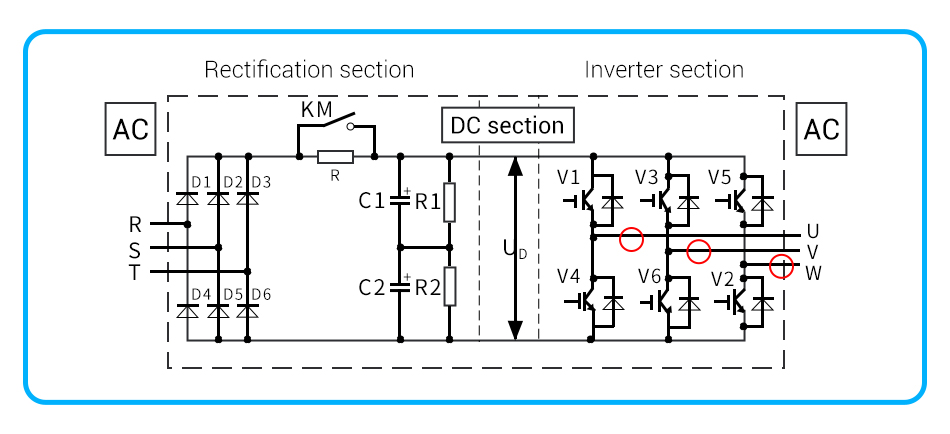Current detection is a common measurement in industrial equipment, and the detection methods are mainly divided into two types: direct and indirect. The direct type uses a current divider which is connected in series with the circuit. This solution is more suitable for small current detection applications, because if the current is large, the test result will be affected by power heating and other factors. The indirect type refers to the use of current transformers or Hall current transducers for measurement without insertion loss, of which Hall current transducers are the better choice for precision measurement of AC and DC currents due to their advantages in accuracy, linearity, bandwidth, etc. Next, let’s see how MORNSUN’s Hall Current Transducers can help to reduce costs and increase efficiency in a number of typical application scenarios.

Application 1: Photovoltaic(PV) inverter
PV inverter is an important component of the whole PV system, although it accounts for only 8%-10% of the total system cost, but it directly affects the power generation efficiency, operational stability and lifetime. As the inverter shipments and new PV installations are fully related, PV inverter shipments will grow significantly with the booming PV power generation market in the future, and the competition of inverter costs will become increasingly fierce.
The topology of a typical distributed PV inverter includes a DC input link (combine the input current of strings), a DC boost link (Boost MPPT circuit), a DC inverter AC link (DC/AC), and an AC output link (leakage current detection), and current detection is essential in each of these links.

At present, most PV inverter designers choose open-loop Hall current sensors on the DC side, because the sampling current on the DC side is generally only for measurement and protection, not for control functions, and the measurement accuracy of 1%-2% can meet the requirement of use, and because it is DC current, the bandwidth requirement is not high, so the choice of low-cost open-loop Hall current transducers may be sufficient.
On the AC side, most PV inverter customers use closed-loop Hall current transducers, because the AC side requires the sampling current signal to be fed back to the microcontroller for control, and the higher the accuracy (0.3%-0.8%), the higher the accuracy of the control output current. At the same time, the bandwidth of the closed-loop Hall current transducers is as high as 100-200KHz, which can more finely detect the current disturbance caused by high-frequency modulation.
Application 2: Frequency converter
The frequency converter is a kind of adjustable speed drive system, which applies frequency conversion drive technology to change the frequency and amplitude of the AC motor working voltage to smoothly control the speed and torque of the AC motor. The biggest advantage of the frequency converter is that it can provide the required supply voltage according to the actual needs of the motor, thus achieving the purpose of energy saving and speed regulation, and also integrating over-current, over-voltage, overload, and other protections. With the increasing level of industrial automation, frequency converters have been very widely used.
As shown in the figure below, a typical frequency converter main circuit topology includes a three-phase rectification section (AC/DC), a DC section, and an inverter section (DC/AC), and both the DC section output and the inverter section output must also implement current detection.

Current sampling on the DC side is only used to detect faults of bridge arm, with low requirements for accuracy, but high requirements for response time (μs level), so an open-loop Hall current transducer can be selected. There are some solutions for the protection of the bridge arm through is achieved by intelligent drive optocoupler, the DC side can even omit the current detection part.
AC current measurement detection is used to achieve dead-time compensation, no trip current closed loop, overload protection, overcurrent protection, open-phase protection and other functions. It has high requirements for the accuracy, linearity, and response time of current detection, and in order to avoid misoperation or protection misoperation, a closed-loop Hall current transducer with high accuracy and linearity will be selected.
Solution: MORNSUN Hall current transducer
With a complete and stable supply chain and strong production capacity, MORNSUN ensures on-time delivery to our customers as always. MORNUSN has launched the Hall closed-loop current transducer TL series, which features cost-effectiveness, high accuracy, high-frequency bandwidth, low-temperature drift, etc., perfectly meeting the current sampling needs of in various industries and helping customers to reduce costs and increase efficiency.

Last but not least, share the following points of attention in the application of current sensors.
1. The primary side wire of the current transducer can fill the aperture, depending on the transducer aperture can reasonably choose a copper row or copper bar, etc.
2. The primary side wire is inevitably formed closed-loop, in order to avoid the effect of the core peripheral current on the transducer, the primary side wire should be far from the transducer for a closed-loop.
3. There should be no strong magnetic fields such as transformers, high-current conductors, etc. near the transducer installation location.
4. The current to be measured should be close to the standard rated IPN value of the transducer.
For more information, please visit www.mornsun-power.com






